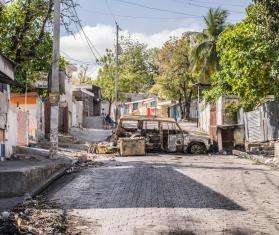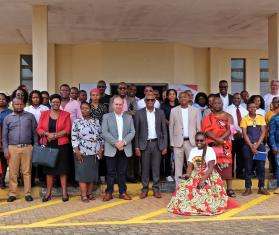Tucson, Arizona, April 25, 2024—Doctors Without Borders/Médecins Sans Frontières (MSF) is temporarily working alongside Tucson-based nonprofits to better understand the medical humanitarian needs of asylum seekers crossing the US-Mexico border near the Sonoran Desert, the organization announced today.
Every year, thousands of asylum seekers and migrants take this route, crossing the US southern border into Arizona’s Pima and Santa Cruz counties on foot via the Sonoran Desert. This is a treacherous route through a remote region without shelter or basic services, and several hours away from the nearest hospital. Asylum seekers and migrants traverse very rough terrain where the weather can be extreme—freezing nighttime temperatures in winter, and blazing hot temperatures and rain in the summer months. The intense conditions put people at high risk of death from various factors, including from freezing temperatures, heat, dehydration, physical exertion, and exposure.
In the summer of 2023, southern Arizona saw a dramatic increase in the number of asylum seekers crossing several areas through or near the border wall. Asylum seekers are often left by guides at different points near the border wall in the Sonoran Desert and told that they can surrender to Border Patrol there to apply for protection in the US, but this isn’t true. In fact, asylum seekers must walk for hours through extreme terrain to reach the nearest Border Patrol station, or wait for hours, exposed to the elements, until they can be picked up by Border Patrol.
“In recent months, we continue to see asylum seekers arriving in remote areas and we welcome the support and awareness that Doctors Without Borders is bringing to this extremely concerning situation,” said Laurie Cantillo, Chair of the Board of Humane Borders, a southern Arizona nonprofit organization providing water stations and humanitarian aid in the Sonoran Desert. “This is more than a political issue, this is a humanitarian and medical issue. We want to shine a light and alleviate this human suffering.”
Last weekend, the Doctors Without Borders team was in Sasabe, Arizona, more than 18 miles (about 30 kilometers) from the closest official point of entry, when approximately 240 asylum seekers arrived. They had walked for several hours from the drop-off area at the border wall. Border Patrol was only able to pick up approximately 48 people, said MSF. The rest of the group had to either wait for a pick-up several hours later or make their way on foot to a US Customs and Border Protection processing center. The group MSF saw included families and unaccompanied minors.

“We’re expecting rain and much warmer summer temperatures soon,” said Belen Ramirez, MSF project coordinator in Arizona. “I’m thinking about the two-year-old we saw out there last weekend and how quickly children become dehydrated in the heat. Without faster processing and greater capacity for transporting these asylum seekers, the situation here will become disastrous.”
The public is prohibited from transporting migrants to Border Patrol stations. Even establishing basic services such as water stations and latrines requires permission from landowners.
The small MSF team, comprised of a project coordinator, medical doctor, and social worker, has been working alongside Humane Borders and other nonprofit groups for the past two weeks to assess the medical needs in the region and suggest ways to build capacity for increased services and collaborations. MSF expects to conclude this assessment by early May.
“The local groups here are doing incredible work to help people on the move,” said Ramirez. “We are here to support them and lend some more urgency to their message: this is a humanitarian issue that demands more resources.”
Humane Borders needs financial support and additional volunteers, especially in the summer months when staffing is short. The group, which locates its water stations on government and privately-owned land with permission from landowners, also needs a faster process to secure these permits as the needs are expected to increase.
“We can’t just leave human beings out there without basic necessities like water and shelter from the scorching heat,” said Cantillo. “Without additional support, we are concerned that once the summer heat arrives, we will be facing an unprecedented number of deaths.”

For over a decade, MSF has provided medical care and psychosocial support to people on the move along the migration routes through Central America to the United States. MSF has long documented the challenges faced by migrants on these routes, including new US policies that create barriers to the right to seek asylum.
As of 2023, most people trying to seek asylum at the US southern border must request an asylum hearing appointment by using a mobile app known as CBP One. The idea behind the app is to prevent irregular border crossings and mass migration flows at the border and points of entry. However, asylum seekers have reported a multitude of problems and delays with the app. Many of them remain stranded in dangerous border cities in Mexico awaiting an appointment for weeks and even months.
“We talked with people who had tried to seek asylum using the app, but some people are waiting for months in Mexico, and it’s just too dangerous,” said Ramirez. “The longer you stay, the more vulnerable you are to violence in these cities.”

17 days in captivity along the US-Mexico border
Read moreAccording to the International Organization for Migration (IOM), the US-Mexico border is the deadliest land crossing in the world, with nearly half of all migrant deaths occurring in the Sonoran and Chihuahuan Deserts. The Tucson sector now ranks as the nation’s busiest border corridor. US Customs and Border Patrol statistics reflect a 133.9 percent increase in migrant encounters in the Tucson sector since last fiscal year, which ran from October 1, 2022 to September 30, 2023.
“Policies to deter migration only force people to take more dangerous routes, and that’s certainly the case for asylum seekers arriving in the Arizona desert,” said Ramirez. “President Biden promised a more humane asylum system. A more humane system must include resources to ensure the safety and survival of asylum seekers arriving at the US southern border.”




